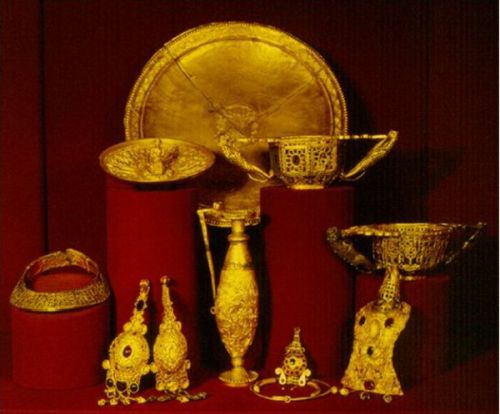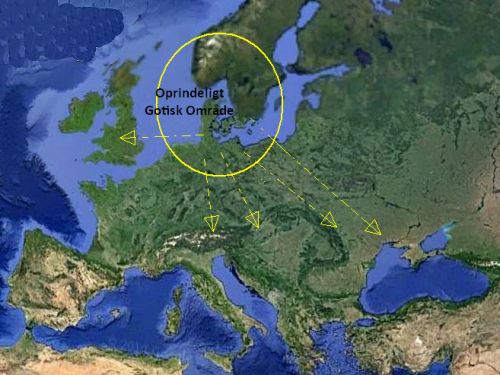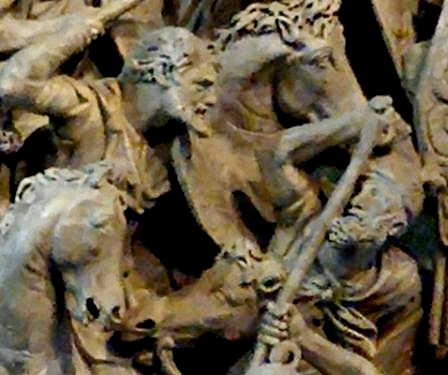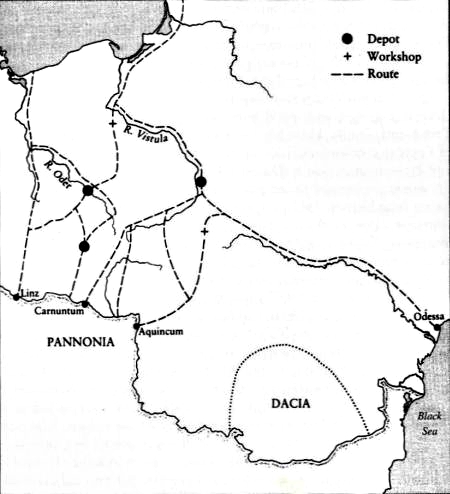
EARLY HISTORY OF THE GOTHS
Jordanes describes how his own people, the Ostro-Goths, originally came from the interior of the Scandinavian Peninsula, perhaps from the Gøta lands: “The same mighty sea has also in its Arctic region, that is in the north, a great island named Scandia, from which my tale (by God’s grace) shall take its beginning. For the race, whose origin you ask to know, burst forth like a swarm of bees from the midst of this island and came into the land of Europe. But how or in what wise we shall explain hereafter, if it be the Lord’s will.”
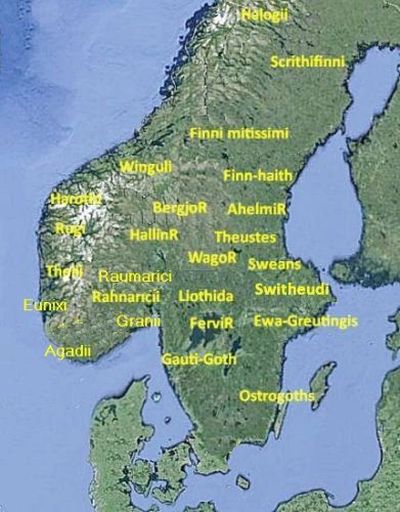
The tribes on the island Scandza after Jordanes – quite randomly placed by the author. We can place Halogi, Scrithfinni, Finn Haith and Finni Mitissimi north after their names. Sweans and Switheudi around Malern – as we believe that they are the Swedes. Gautigoths and Ostrogoths in the Gøta lands, Dani in Scania and some people reminiscent of modern Norwegian place names, Raumarici and Agadii as well as possible in Norway. The rest I have placed pretty randomly.
Jordanes lived around 550 AD in Constantinople. It is assumed that the Ostrogoths left Scandza around 150 AD. If a generation is considered to 25 years, it will then be 16 generations since they left the Scandinavian Peninsula. In all that time they had preserved the memory of the country that they left long ago, orally from generation to generation. That witnesses of a strong sense of national identity. Another possibility is that they had a sporadic connection to their original homeland all the time.
“Now from this island of Scandia, as from a factory of races or a vagina of nations, the Goths are said to have come forth long ago under their king, Berig by name. As soon as they disembarked from their ships and set foot on the land, they straightway gave their name to the place. And even to-day it is said to be called Gutisk-Andja”
“Soon they moved from here to the abodes of the Hulm-Rugians, who then dwelt on the shores of the Ocean,” Jordanes continued, “where they pitched camp, joined battle with them and drove them from their homes. Next, they subdued their neighbors, the Vandals, and thus added to their victories.”
It is believed that the Ostro-Goths went ashore in what today is modern Poland, at the mouth of River Vistula. It happened around 150 AD
Archaeologists have unearthed burial sites in the Vistula River delta and lower reaches, which exhibit many common features with contemporary burial sites in southern Scandinavia. The culture has been baptized the Wielbark culture after the main findings place. There have been found both inhumation grave and cremations, just as is the case in Jutland and Gøta lands at the same time. The deceased is laid to rest in stone-built tombs, and they have rarely been given weapons, but sometimes spores, which is also a similarity with inhumation graves in Jutland at the same time. Most believe that the Wielbark culture can be attributed to the Goths and Getae, but not everyone is convinced. The graves have been dated from the first century until 300-400 AD.
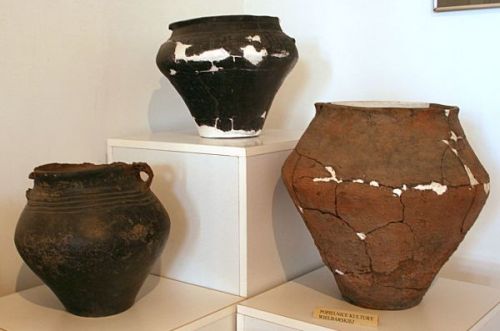
Ceramics from the Wielbark culture exhibited in the Polish Museum Odry
When the Goths had lived for a while at the Vistula River delta, they decided to go south, where, however, a disaster awaited them. Jordanes recounts: “But when the number of the people increased greatly and Filimer, son of Gadarik, reigned as king about the fifth since Berig, he settled on the plan that the army of the Goths with their families should move from that region. In search of suitable homes and pleasant places, they reached the lands of Scythia, which in their tongue are called Oium. Here they were delighted with the great richness of the country, and it is said that when half of the army had been brought over, the bridge, whereby they had crossed the river, collapsed irreparably, nor could anyone thereafter pass to or fro. For the place is said to be surrounded by quaking bogs and an encircling abyss, so that by this double obstacle nature has made it inaccessible. Indeed, one might give credence to the assertions of travelers even if they have heard it from afar that in that area even today the lowing of cattle is heard and traces of men are found.”
Normally, it is not expected of a king, a responsible leader, to abandon half of his people in the wilderness and just leave them to their fate. One must think that the situation was desperate.
In this way the Gothic army and their families became split into two parts, namely the group that already had crossed the river led by Filimer, and the remaining group, which did not manage to get across the river: “So having crossed the river, this part of the Goths which migrated with Filimer went into the territory of Aujom, they say, took possession of the desired land. There they quickly came upon the race of the Spali, joined battle with them and won victory.”
|
|
The Pietroasele treasure was found in Pietroasele near Buzau in Romania in 1837. It is a Gothic treasure from the fourth century. It is on display at the National Museum of Romanian History in Bucharest. Originally it consisted of 22 pieces, but only 12 have been preserved including a neck ring with a Gothic runic inscription in older futhark – photo Wikipedia.
“Thence the victors hastened to the farthest part of Scythia, which is near the sea of Pontus; for so the story is generally told in their early songs, in almost historic fashion,” Jordanes recounts. “To return, then, to my subject. The aforesaid race of which I speak is known to have had Filimer as king, while they remained in their first home in Scythia near the Sea of Asov.”
Only now, Jordanes mentions that Filimer’s people were divided into two groups of Goths, led each by its own dynasty: “In their third dwelling place, which was above the Black Sea, they had now become more civilized and, as I have said before, were more learned. Then the people were divided under ruling families. The Visigoths served the family of the Balti and the Ostrogoths served the renowned Amali.”
Jordanes tells nothing about what became of the part of the original group that was cut off because of the disaster at the bridge.
Especially previously, most historians believed that Visigoths and Terwingi were only different names for Western Goths and Ostrogoths and Greuthungi were other names for the Eastern Goths. But we must remember that Jordanes told that both Ostrogothae and Ewa-Greutingi were tribes that populated the interior of the island Scandia; this alone makes it unlikely that Ostrogoths and Greutungi was one and the same.
They looked like each other and spoke the same language, as Procopius wrote. So they must also have had the same origin: the original Gothic area in Southern Scandinavia and around the Baltic Sea. Most likely it had been a bit by random if the ancient writers included Greutungi, Terwingi, Rugi, Vandals and Gepids in the group of Goths or not. Most of the tribes, who arrived into the Roman Empire through the Black Sea coast, were classified as Goths, while other, who did not come in contact with the Roman world via the Black Sea area, were not, even though they spoke Gothic.
It is tempting to recall that all Gothic areas on the southern Scandinavian peninsula and along the Baltic Sea and inner Danish waters were very densely populated in Roman Iron Age, if not overpopulated. One can easily imagine that other Gothic people tried their luck in the south. However, they did not have a chronicler, like the Ostrogoths had in Jordanes.
Jordanes wrote about the emigration from the Vistula delta that Filimer decided: “that the army of the Goths with their families should move from that region”, he did not write that the entire people emigrated. A migrant people like Filimer’s Goths, who went through relatively sparsely populated areas and even were halved by the disaster with the collapsed bridge, may, for logistical reasons, not have included much more than maybe a few thousand people.
In connection with the disaster at the bridge, the story mentions that long after, one could hear the roaring of cattle at the abyss; it indicates that the Goths brought their cattle. But there would have been limits on how much cattle and thus how many people, who could travel the same path, for there must be grass for the cattle.
They arrived at the northern coast of the Black Sea about 170 AD, and already around 250 AD – only three generations after – they were numerous enough to populate most of southern Ukraine and Romania, to conclude agreements with the Roman Empire and subsequent to attack the nearby Roman provinces. It must have required a Gothic population of several hundred thousand. This means that if Filimer’s Goths had been the only origin to the numerous Gothic population in the area, then they should have performed a bluntly miraculous fertility, which seems very unlikely also with the contemporary living conditions considered.
Battle scene between Romans and Germans or Dacians on the Portonaccio sarcophagus. The barbarians all have curly hair and beard, The man in bottom right has a kind of cap or helmet – which is said to be characteristic for Dacians – otherwise, only the Roman soldiers carry helmets. The sarcophagus is found in Rome and dated to the 2. century – Photo Wikipedia.
It is much more credible that the Gothic population in southern Ukraine was made up by many small groups – similar to Filimer’s Goths – which had emigrated from the over-populated original Gothic area in the north, but only Filimer’s Goths got their quest immortalized by a chronicler. The historian Peter Heather mentions, for example, at least seven different groups of Goths.
Amminius wrote about the reason for the Goth’s later wish to seek refuge in the Roman Empire: “Yet when the report spread widely among the other Gothic peoples, that a race of men hitherto unknown had now arisen from a hidden nook of the earth, like a tempest of snows from the high mountains, and was seizing or destroying everything in its way – ” The phrase: “the other Gothic peoples” clearly gives the impression that there were many Gothic peoples and not only two.
Moreover Athanaric, who was king of the Western Goths, wanted to establish a defense against the Huns, but other leaders, Alavivus and Fritigern, preferred to seek shelter inside the Roman Empire with their subgroups and left Athanaric and the rest of the Western Goths to their fate. If the Western Goths had been a homogeneous group, which Jordanes suggests, could we then imagine such desertion?
Likewise with the Eastern Goths, led by Alatheus and Saphrax; they ran away from it all and left the rest of the Eastern Goths face to face with the Huns. Would they have done this, if the Eastern Goths had been a homogenous group, one people with a common history? It is much more likely that both the Western and the Eastern Goths were coalitions of many original groups.
The main route of the ancient amber trade went down along the river Vistula and then to Carnuntum in Austria halfway between Vienna and Bratislava, from there the route led to the River Po, which in ancient times was called Eridanos, where there was a market for amber. In addition, several other very old trade routes have been identified in Eastern Europe. Already in the Bronze Age amber, bronze and slaves were transported along these routes. We can imagine that the Cimbri and Teutons traveled down along the Oder to Linz on their infamous raid. We must believe that many groups of Goths with their kilometer long road trains followed the rivers Vistula and Dnieper to the coast of the Black Sea. The amber routes were well known even in Rome, for example Emperor Nero sent an agent to the Baltic to buy a large quantity of amber for decorations of the imperial palaces. – From “The Goths” by Peter Heather.
Ptolemy placed the people Goutai on the island of Skandia while the people Gudones at the Vistula River. It is most often explained as a kind of mistake or name confusion, but the right explanation is probably that already then were several groups of Goths; It is also historian Herwig Wolfram’s view.
The Gothic armies have likely been composed of many different groups of Goths, who identified themselves with the names of their original homes in the north or the names of their leaders as Procopius said; such as Ostro-Goths, Greuthungi Goths, Gaiti-Goths, Visi-Goths, Terwingi Goths, Rugi and Rheid-Goths. Eudoses has likely originated from Jutland. Scirii is said to have spoken a Gothic language, though no ancient sources call them Goths. One can imagine that the Gothic area north of the Black Sea was a kind of that time America, where different groups of emigrants from the original Gothic area became mixed together in alternating coalitions.
A very large Gothic group under Radagaisus went directly against Italy but was stopped at Florence by a Roman army of overwhelming strength. Nothing is said about them to be Eastern or Western Goths; they were only a kind of Goths, who came more or less directly from the Goth’s northern homeland.
Preserving the Past, Recording the Present, Informing the Future
Ancient and Honorable Carruthers Clan Int Society
carruthersclan1@gmail.com carrothersclan@gmail.com

Dr Patricia Carrothers
Reviewed by Tammy Wise CHS
CLAN SEANACHAIDHI
CLAN CARRUTHERS INT SOCIETY CCIS HISTORIAN AND GENEALOGIST

You can find us on facebook at :
https://www.facebook.com/carrutherscarrothers.pat.9
https://www.facebook.com/CarruthersClan/
https://www.facebook.com/CarruthersClanLLC
Disclaimer Ancient and Honorable Carruthers Clan International Society



